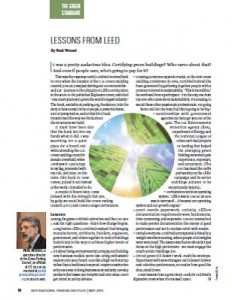It was a pretty audacious idea. Certifying green buildings? Who cares about that? And even if people care, who’s going to pay for it?
That was the response David Gottfried received back in 1992 when the founder of the U.S. Green Building Council (USGBC) was just starting out. He recounts his—and our—journey to the ubiquity of LEED certification in the soon-to-be published Explosion Green, subtitled “One man’s journey to green the world’s largest industry.” The book, available at parking.org/bookstore, tells the story of how a small circle of people, a powerful vision, a lot of perspiration, and a little bit of luck transformed the way we think about the structures we build.
It must have been fate that the book fell into my hands when it did. I was searching for a quiet place for a board call while attending the U.S. Green Building Council’s annual Greenbuild, when I first saw it. I put a copy in my bag, proceeded with my call, and later, on the train ride back to New Haven, pulled it out instead of the work I intended to do.
A couple of hours later, I was infused with the strength that yes, by golly, we could build the Green Parking Council (GPC) and Green Garage Certification.
Lessons
Among the gems Gottfried offered me and the GPC are:
Ask the right questions—that’s how change begins. Long before LEED, Gottfried realized that bringing manufacturers, architects, builders, engineers, government, and others together to look at buildings holistically is the way to achieve higher levels of performance.
It’s about being entrepreneurial, scrappy, and building new business models. Move fast. Bring enthusiastic leaders onto your board. Run like a high-tech startup rather than a traditional nonprofit. Inspire constructive action as a way of doing business as an industry. Develop products that lessen our footprint and offer value. Don’t get mired in policy debates.
Creating a common space is crucial. At the first Green Building Conference in 1994, Gottfried noticed the buzz generated by gathering together people with a common interest in sustainability. “This is incredible,” he overheard from a participant. “I’m the only one from my firm who cares about sustainability. It’s amazing to see all these other passionate professionals. I’m going home and tell my boss that this is going to be big.”
Relationships with government agencies can help get you out of the gate. The U.S. Environmental Protection Agency (EPA), Department of Energy, and the National League of Cities each had projects or funding that helped the emerging green building movement gain experience, exposure, and acceptance. (The GPC has found the DOE’s partnership on the LEEP campaign and its Better Buildings Alliance to be exceptionally helpful.)
Certification can be an operating system. “LEED was to USGBC as DOS was to Microsoft … it became our operating system and our growth engine.”
Don’t overdo paperwork. Initially, LEED’s documentation requirements were burdensome, time-consuming, and expensive. USGBC learned not to make perfect documentation the enemy of good performance and not to confuse effort with results.
Include everyone. Gottfried accompanied a friend to a Weight Watchers meeting, where people of all weights were welcomed. The lesson was that we shouldn’t just focus on the high performers—we must engage the couch-potato buildings, too.
It’s not green if it doesn’t work. Push the envelope. Experiment with new strategies. But if doesn’t deliver cost-effective performance, no matter how good the idea, stand down.
Great lessons from a great story. Look for Gottfried’s Explosion Green when it’s released June 1.
Paul Wessel is executive director of the Green Parking Council, an affiliate of IPI. He can be reached at paul@greenparkingcouncil.org or 203.672.5892.

